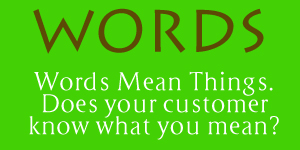
Let’s talk about messaging and how to create messages and content your reader will read, register, and remember!
How often have you read something and immediately forgotten what you just read? Or, heard an advertisement only not to remember the product it was supposed to be selling? How about this one: How often have you walked into the grocery store and looked around for the little hand baskets yet not found them? Yet, they were right there.
If you can understand how your brain – or your customer’s brain – behaves in certain circumstances, you can create messaging that will get into their conscious thinking and stay there.
Understanding the target reader is the most crucial factor in the content creation process. In today’s information-overloaded world, bypassing messaging is sometimes more important than hearing it. There’s just too much information! I don’t need to know that Anthony Weiner cheated on his wife again! I don’t care that some movie star went out in sweatpants! Yet, my phone constantly sends me information just like that. Emails… texts… Instagram posts… billboards… phone calls… newspapers… Facebook notifications… Tweets… OMG, please STOP!
How can you ever expect to create content that will get past all that noise? The first step is to understand what your target audience wants to hear. Then give it to them.
Your brain is preprogrammed to give immediate conscious access to three things:
- Things we value
- Things that are unique
- Things that are threatening
So, by making your messages fit one of these categories, you get into the brain’s consciousness instead of its subconscious. If you know what your audience values, make sure your messaging is valuable. You win if you have a unique product, message, or opportunity. Be boring; you lose. I always say being different is much better than being better.
Your brain has three sections: the neocortex, which is where we do the processing of analytical things like math, science, or reading. It is the thinking part of our mind. The second part is your midbrain. This is where we process social situations like first impressions, self-consciousness, and feelings. And the last part – which I call the lizard brain – is where we process urgent and critical things. This is where the reticular activating system resides. This part of our brain decides, do I eat it, kill it, or mate with it?
When you encounter an angry, rabid dog, your neocortex doesn’t say, hmmm? That dog weighs roughly 45 pounds and is approximately 60’ away. Based on that calculation and my typical running speed, I can get to my car – which is 40’ away, just before he bites me. REALLY? No, your lizard brain immediately and without hesitation says, RUN!
So, get their attention by understanding what they value. Keep their attention by offering value or uniqueness.
“How do I get them to remember it, you ask?” So glad you did.
Our minds have banks of information that are grouped by association. Let me explain. When I say ‘football,’ you immediately have a synaptic reaction. Your brain begins tapping into the schema – a fancy word for the group – of information related to that word. So you immediately think of your favorite NFL team, their colors come to mind, their quarterback enters your mind, you’re reminded of their crappy season, and so on. You get the point. But, if I say the word anthropology – like Curly on the three stooges – you’re trying to think, but nuttin’ happens. In other words, you don’t have a vast scheme of anthropology-related information. So… nuttin’ happens.
By hanging your message on the existing schema inside your customer’s brain, you gain quick and nearly immediate access over the limen threshold (look that one up) and into your prospective customer’s brain. BAM! Geico is masterful at using metaphors, stories, and imagery that they know you already have in your brain. They hang their message on what you know, and they’re in. Message received, registered, and conscious. Mike drop!
Creating content and messaging your readers will read and care about isn’t rocket science, but it takes some skill. I hope these tips will help you write better content and get better results.